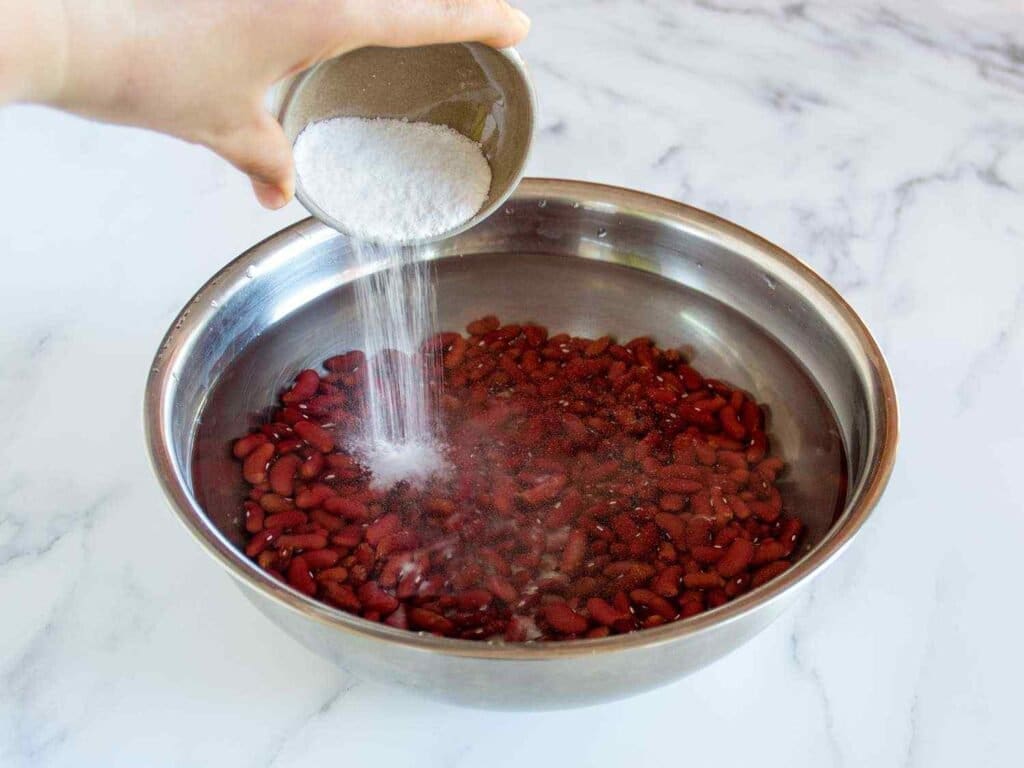I’ve had my fair share of kitchen mishaps, and a pot of bitter beans is right up there with the worst of them. Luckily, a few tricks up my sleeve can salvage even the most astringent legumes.
If your beans are bitter, try soaking and rinsing them before cooking, adding a pinch of baking soda to the cooking water, or balancing the flavor with sweetness, acid, or fat.
Curious about how these methods work? Read on for chef-approved tips to rescue your beans and turn them into a culinary triumph.
1. Soak and Rinse

Soaking and rinsing your dried beans is a crucial first step, and skipping it would be a big mistake. Those beans are going to be bitter and the texture will be all wrong.
Grab a large bowl and dump your beans in there. Cover them with a generous amount of cold water. And when I say generous, I mean really generous. You want those beans fully submerged.
Now, here’s where patience comes in. Let those beans soak for at least 4 hours. Got some extra time on your hands? Let them soak overnight. Trust me, it’s worth it. This soaking process is what’s going to get rid of that unpleasant bitterness.
After soaking, you need to rinse those beans. And I mean really rinse them. Put them under cool running water and let it flow.
You’ll probably notice the water looks a bit dirty at first. That’s normal. Just keep rinsing until that water runs clear.
Why is rinsing so important? Well, it gets rid of any lingering bitterness and also washes away any dirt or debris that might be stuck on your beans. You don’t want that ending up in your dish, do you?
2. Baking Soda

Baking soda: the unsung hero of bean cooking! This humble pantry staple can work miracles when it comes to getting rid of that pesky bitterness in your beans.
So, what’s the secret behind its magic? It all boils down to chemistry.
Baking soda, or sodium bicarbonate, is naturally alkaline. When added to your bean soaking water, it neutralizes those bitter compounds, leaving you with beans that taste as they should – earthy, nutty, and delicious.
Now, you might be wondering, ‘How much baking soda do I need?’ It’s simple – just a pinch will do. We recommend about 1/4 teaspoon for every pound of dry beans.
Toss it into the soaking water and let the beans hang out for at least 4 hours, or even better, overnight. The longer they soak, the more time the baking soda has to work its magic.
But wait, there’s one crucial step you can’t skip! After soaking, make sure to give your beans a good rinse under running water.
This gets rid of any excess baking soda that might mess with the texture or flavor of your finished dish. Once they’re rinsed and ready, cook your beans as usual and get ready to be amazed at the difference in taste.
3. Sweetness

Sweetness to the rescue! When your beans turn out more bitter than expected, don’t toss ’em out just yet. A little sugar, honey, or molasses can work miracles in balancing those harsh flavors.
Start with a small amount – a teaspoon or two of sugar or a drizzle of honey should do the trick.
Gradually add more until you hit that sweet spot where the natural sweetness complements the beans’ earthy taste without stealing the show.
The type of sweetener matters, too. White sugar keeps it simple, while brown sugar, honey, or molasses add depth and richness. Play around with different options to find your bean’s perfect match.
4. Acid

Balancing bitterness in beans can be a real pain, but adding a splash of acidity is a total game-changer.
Lemon juice, vinegar, or even tomatoes can work wonders in evening out those bitter flavors. And don’t worry, you don’t need to be a kitchen wizard to pull this off.
Check out this handy table:
| Acid Source | Amount to Add | Best For |
|---|---|---|
| Lemon Juice | 1-2 tsp | Lighter beans like navy or cannellini |
| Apple Cider Vinegar | 1-2 tsp | Heartier beans like black or kidney |
| Diced Tomatoes | 1/4 to 1/2 cup | Recipes with tomato-based sauces |
| White Wine Vinegar | 1-2 tsp | Mediterranean-style bean dishes |
It’s all about matching the right acid to the right bean. Lemon juice is perfect for those delicate, light-colored beans, while apple cider vinegar can stand up to the bolder flavors of black or kidney beans.
And if you’re whipping up a dish with a tomato-based sauce, tossing in some diced tomatoes is a no-brainer.
But what about those Mediterranean-inspired bean dishes? White wine vinegar is your secret weapon. Just a teaspoon or two can brighten up the flavors and transport your taste buds straight to the sunny coast of Greece.
5. Fat

Fat is your friend when it comes to taming those bitter beans. Olive oil, butter, cream – they’re all great options for mellowing out harsh flavors.
The richness coats your tongue, masking the unpleasant taste and making the beans more palatable.
When cooking your beans, try sautéing them with some chopped bacon or pancetta. The rendered fat will infuse the beans with a savory flavor that balances out any lingering bitterness.
Or, add a spoonful of sour cream or crème fraîche to your finished dish. The tangy creaminess provides a nice contrast and rounds out the overall flavor profile.
Don’t be afraid to embrace fat as a flavor-enhancing tool. A little goes a long way in transforming bitter beans into a delicious, well-rounded dish. So go ahead, drizzle, dollop, and sauté your way to bean perfection.



